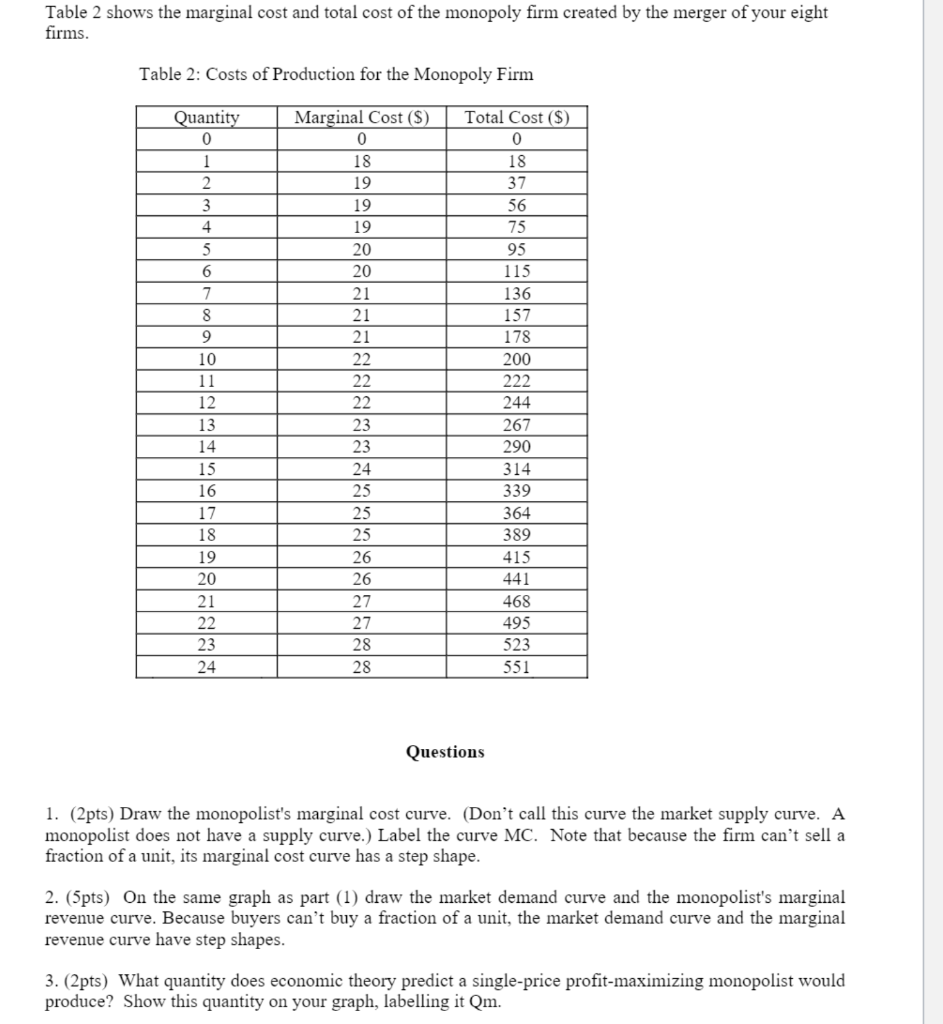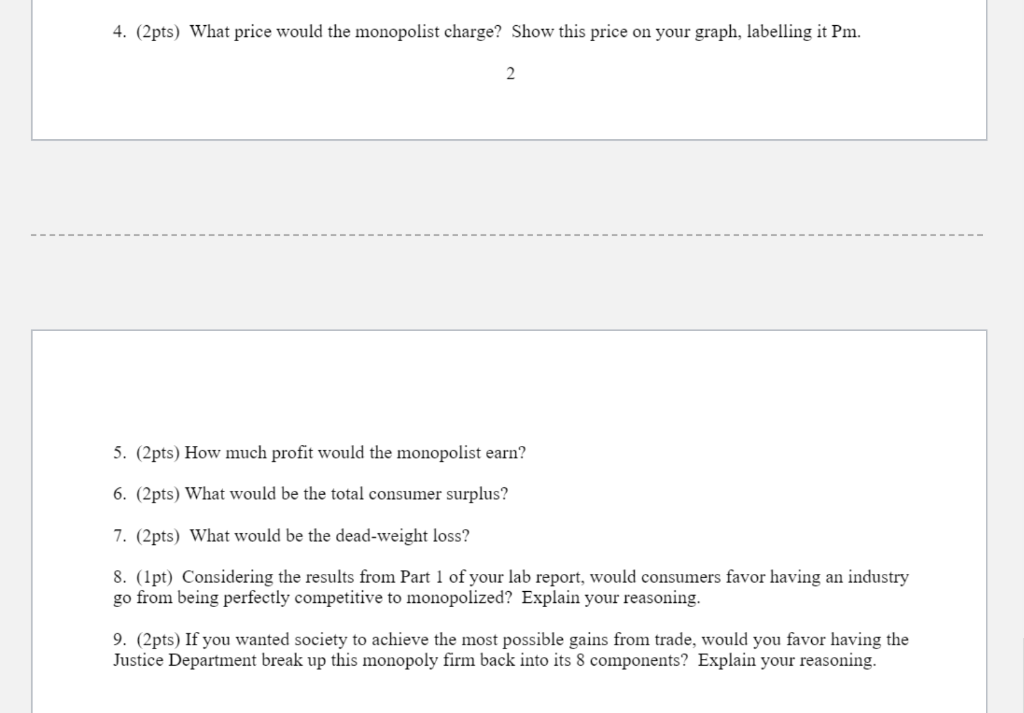


Buyer's ID 1 2 3 4 5 6 7 8 9 Table 1: Consumption Values for the Buyers Value of first widget ($) Value of second widget ($) 48 25 44 26 42 24 47 23 45 20 46 19 37 18 43 17 38 21 41 27 40 28 39 22 36 16 31 15 33 12 35 11 30 10 32 14 34 13 29 9 10 11 12 13 14 15 16 17 18 19 20 Your firm was created by the merger of eight firms who were previously competitors in producing widgets. Your firm became the sole producer of widgets. Your firm had no fixed costs of production, incurred no costs for widgets you offered for sale that did not sell, and could not store widgets between periods. Your firm could not charge different prices to different buyers. Suppose there are no externalities in the widget market, i.e., no third parties affected in a positive or negative way by widget production or consumption. Table 2 shows the marginal cost and total cost of the monopoly firm created by the merger of your eight firms. Table 2: Costs of Production for the Monopoly Firm Quantity 0 Marginal Cost ($) 0 1 2. 3 4 5 6 7 8 9 10 11 12 13 14 15 16 17 18 19 20 21 22 23 24 18 19 19 19 20 20 21 21 21 22 22 22 23 23 24 25 25 25 26 26 27 27 28 28 Total Cost ($) 0 18 37 56 75 95 115 136 157 178 200 222 244 267 290 314 339 364 389 415 441 468 495 523 551 Questions 1. (2pts) Draw the monopolist's marginal cost curve. (Don't call this curve the market supply curve. A monopolist does not have a supply curve.) Label the curve MC. Note that because the firm can't sell a fraction of a unit, its marginal cost curve has a step shape. 2. (5pts) On the same graph as part (1) draw the market demand curve and the monopolist's marginal revenue curve. Because buyers can't buy a fraction of a unit, the market demand curve and the marginal revenue curve have step shapes. 3. (2pts) What quantity does economic theory predict a single-price profit-maximizing monopolist would produce? Show this quantity on your graph, labelling it Qm. 4. (2pts) What price would the monopolist charge? Show this price on your graph, labelling it Pm. 2 5. (2pts) How much profit would the monopolist earn? 6. (2pts) What would be the total consumer surplus? 7. (2pts) What would be the dead-weight loss? 8. (1pt) Considering the results from Part 1 of your lab report, would consumers favor having an industry go from being perfectly competitive to monopolized? Explain your reasoning. 9. (2pts) If you wanted society to achieve the most possible gains from trade, would you favor having the Justice Department break up this monopoly firm back into its 8 components? Explain your reasoning. Buyer's ID 1 2 3 4 5 6 7 8 9 Table 1: Consumption Values for the Buyers Value of first widget ($) Value of second widget ($) 48 25 44 26 42 24 47 23 45 20 46 19 37 18 43 17 38 21 41 27 40 28 39 22 36 16 31 15 33 12 35 11 30 10 32 14 34 13 29 9 10 11 12 13 14 15 16 17 18 19 20 Your firm was created by the merger of eight firms who were previously competitors in producing widgets. Your firm became the sole producer of widgets. Your firm had no fixed costs of production, incurred no costs for widgets you offered for sale that did not sell, and could not store widgets between periods. Your firm could not charge different prices to different buyers. Suppose there are no externalities in the widget market, i.e., no third parties affected in a positive or negative way by widget production or consumption. Table 2 shows the marginal cost and total cost of the monopoly firm created by the merger of your eight firms. Table 2: Costs of Production for the Monopoly Firm Quantity 0 Marginal Cost ($) 0 1 2. 3 4 5 6 7 8 9 10 11 12 13 14 15 16 17 18 19 20 21 22 23 24 18 19 19 19 20 20 21 21 21 22 22 22 23 23 24 25 25 25 26 26 27 27 28 28 Total Cost ($) 0 18 37 56 75 95 115 136 157 178 200 222 244 267 290 314 339 364 389 415 441 468 495 523 551 Questions 1. (2pts) Draw the monopolist's marginal cost curve. (Don't call this curve the market supply curve. A monopolist does not have a supply curve.) Label the curve MC. Note that because the firm can't sell a fraction of a unit, its marginal cost curve has a step shape. 2. (5pts) On the same graph as part (1) draw the market demand curve and the monopolist's marginal revenue curve. Because buyers can't buy a fraction of a unit, the market demand curve and the marginal revenue curve have step shapes. 3. (2pts) What quantity does economic theory predict a single-price profit-maximizing monopolist would produce? Show this quantity on your graph, labelling it Qm. 4. (2pts) What price would the monopolist charge? Show this price on your graph, labelling it Pm. 2 5. (2pts) How much profit would the monopolist earn? 6. (2pts) What would be the total consumer surplus? 7. (2pts) What would be the dead-weight loss? 8. (1pt) Considering the results from Part 1 of your lab report, would consumers favor having an industry go from being perfectly competitive to monopolized? Explain your reasoning. 9. (2pts) If you wanted society to achieve the most possible gains from trade, would you favor having the Justice Department break up this monopoly firm back into its 8 components? Explain your reasoning









